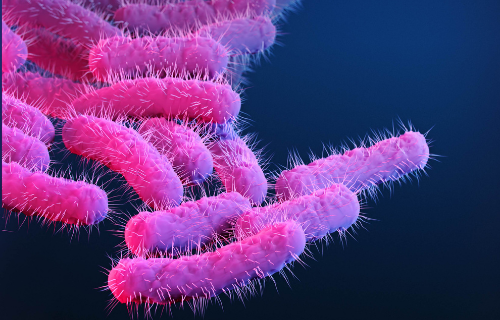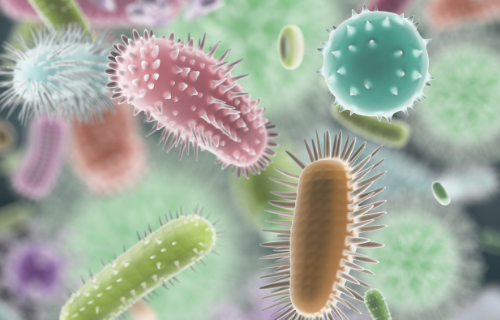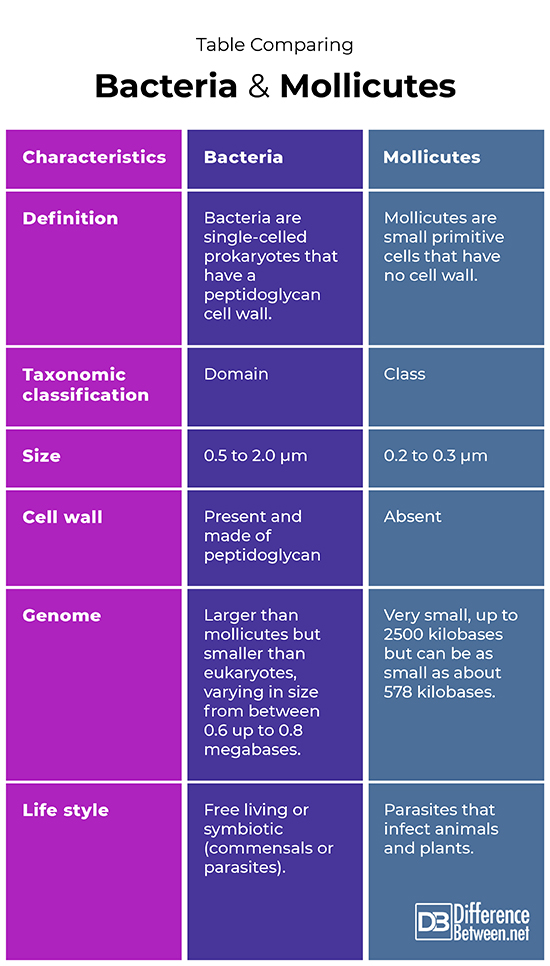Difference Between Bacteria and Mollicutes
Bacteria are organisms that occur as single cells and have a cell wall made up of peptidoglycan molecules. Mollicutes are single-celled organisms that have no cell wall and have only a simple genome.

What is Bacteria?
Definition:
The bacteria are a large taxonomic group, that is classified as a Domain, consisting of several unicellular organisms that have a peptidoglycan cell wall.
Origins:
Bacteria have been present since 3 billion years ago, and they are believed to have arisen from a cell which had RNA as the genetic material.
Structure:
Bacteria are prokaryotic organisms meaning that they have no nucleus and no nuclear envelope. They do have a cell membrane and a cell wall. Bacterial cells, unlike fungal cells, have a cell wall that is made up of a protein and carbohydrate complex called peptidoglycan. The cell has no membrane-bound structures but has a region where DNA is found and the cytoplasm contains ribosomes. The size of bacteria is from 0.2 to 2.0 µm. The genome is from 0.6 to 0.8 megabases.
Habitat and life styles:
There is a diversity of bacteria and they are found in every conceivable habitat. There are helpful bacteria that live inside the gut of animals and humans, and help to digest food and produce useful nutrients. There are also pathogenic bacteria which can cause dangerous and even deadly infections in animals. Food-poisoning and even some types of meningitis in people are caused by bacteria. Many bacteria are free-living and break down dead matter and help recycle nutrients back to the environment. Others that cause illness are parasites, living inside a host plant or animal.
Examples:
Examples of bacteria include Rhizobium, which is helpful in adding nutrients to the soil, which helps plants grow. E. coli, Clostridium difficile, and Streptococcus are harmful bacteria that cause sickness in animals (including humans).

What is Mollicutes?
Definition:
Mollicutes are cells categorized as a class of bacteria that are very small and have no cell wall.
Origins:
It is widely thought that the mollicutes actually arose about 65 million years ago from bacteria that had a gram-positive cell wall. They evolved specifically from the bacteria that did not have a lot of cytosine and guanine nucleotide bases in the DNA. Mollicutes arose sometime after the bacteria evolved.
Structure:
Mollicutes (unlike bacteria) do not possess a cell wall. They are also generally smaller than bacteria and have a smaller genome as well. They have ribosomes and DNA present and are the simplest organisms that can self-replicate. They have a plasma membrane that contains cholesterol, and the shape of the cell is flask-shaped or sometimes coiled. The cells do contain the proteins tubulin and actin.
Habitat and life styles:
Mollicutes have a parasitic life style, meaning that they live in other organisms such as plants and animals. Some are parasites that affect humans and can cause a variety of infections from lung disease to genitourinary infections. Due to the parasitic nature of mollicutes, those that infect insects are even researched as future agents for biological control of pest insects.
Examples:
Examples of mollicutes include Mycoplasma and Spiroplasma. Mycoplasma can infect people, particularly if the immune system is weakened. Spiroplasma is a genus that causes various plant infections.
Difference between Bacteria and Mollicutes
Definition
Bacteria are single-celled prokaryotes that have a peptidoglycan cell wall. Mollicutes are small primitive cells that have no cell wall.
Taxonomic classification
Bacteria are placed in the taxonomic category Domain. Mollicutes are in the category of a Class.
Size
The size of a bacterial cell ranges from roughly 0.5 to 2.0 µm. The size of a mollicute cell varies from 0.2 to 0.3 µm.
Cell wall
A cell wall made up of peptides and glycogen molecules is found surrounding the bacterial cell. No cell wall occurs around a mollicute cell.
Genome
A bacterium has a larger genome than a mollicute being 0.6 to 0.8 megabases. A mollicute has a smaller genome than a bacterium, ranging in size from 578 to 2500 kilobases.
Life style
Bacteria have several different life styles including being free-living or existing as commensals or parasites. Mollicutes are all parasites of either plants or animals.
Table comparing Bacteria and Mollicutes

Summary of Bacteria and Mollicutes
- Bacteria and mollicutes are both single-celled prokaryotic organisms.
- Bacteria are older than mollicutes in evolutionary time.
- Mollicutes are smaller in size and have smaller genomes than bacteria.
- Mollicutes are parasitic organisms while bacteria include many different life-styles including being free-living.
FAQ
How do Mollicutes differ from bacteria?
Mollicutes are much smaller in size and they have no cell wall; the genome is also much smaller when compared to bacterial cells.
What are bacteria and Mollicutes explain their main characteristics?
Bacteria are prokaryotic single-celled organisms that have a peptidoglycan cell wall. Mollicutes are single-celled organisms that do not have a cell wall, have an adenine-thymine rich small genome, and are smaller than bacteria.
Is there a difference between bacteria and bacterium?
The term bacteria is the plural form of the word bacterium. In other words, bacteria refer to several cells while bacterium is a single cell.
What are the parts of Mollicutes?
Mollicutes have a cell membrane, ribosomes, DNA, and proteins like actin and tubulin.
- Difference Between Rumination and Regurgitation - June 13, 2024
- Difference Between Pyelectasis and Hydronephrosis - June 4, 2024
- Difference Between Cellulitis and Erysipelas - June 1, 2024
Search DifferenceBetween.net :
Leave a Response
References :
[0]Bové, J. M. "Molecular features of mollicutes." Clinical Infectious Diseases 17.Supplement_1 (1993): S10-S31.
[1]Encyclopedia Britannica. ”Bacteria”. Encyclopedia Britannica, https://www.britannica.com/science/bacteria
[2]Sirand-Pugnet, Pascal, et al. "Evolution of mollicutes: down a bumpy road with twists and turns." Research in microbiology 158.10 (2007): 754-766.
